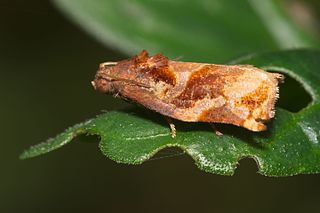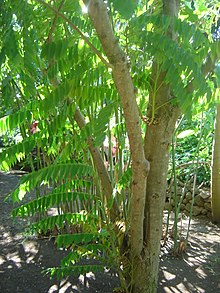
Carambola, or star fruit, is the fruit of Averrhoa carambola, a species of tree native to tropical Southeast Asia. The fruit is commonly consumed throughout Southeast Asia, the South Pacific, Micronesia, and parts of East Asia. The tree is cultivated throughout tropical areas.

The Oxalidaceae, or wood sorrel family, are a small family of five genera of herbaceous plants, shrubs and small trees, with the great majority of the 570 species in the genus Oxalis. Members of this family typically have divided leaves, the leaflets showing "sleep movements", spreading open in light and closing in darkness.

Rapid plant movement encompasses movement in plant structures occurring over a very short period, usually under one second. For example, the Venus flytrap closes its trap in about 100 milliseconds. The dogwood bunchberry's flower opens its petals and fires pollen in less than 0.5 milliseconds. The record is currently held by the white mulberry tree, with flower movement taking 25 microseconds, as pollen is catapulted from the stamens at velocities in excess of half the speed of sound—near the theoretical physical limits for movements in plants.

Averrhoa bilimbi is a fruit-bearing tree of the genus Averrhoa, family Oxalidaceae.

Averrhoa carambola is a species of tree in the family Oxalidaceae native to tropical Southeast Asia; it has a number of common names, including carambola, star fruit and five-corner. It is a small tree or shrub that grows 5 to 12 m tall, with rose to red-purple flowers. The flowers are small and bell-shaped, with five petals that have whitish edges. The flowers are often produced year round under tropical conditions. The tree is cultivated in tropical and semitropical regions for its edible fruits and for its medicinal uses.

Cauliflory is a botanical term referring to plants that flower and fruit from their main stems or woody trunks rather than from new growth and shoots. This can allow trees to be pollinated or have their seeds dispersed by animals which cannot climb or fly. With fruit, plants may instead have fruit which drop from the canopy and ripen only after they reach the ground, an alternative "strategy" to cauliflory.

Tropical Gardens of Maui was a 4-acre (1.6 ha) commercial nursery with botanical garden, located at 200 Iao Valley Road, Wailuku, Maui, Hawaii. The gardens were open daily without charge.

The Jardin de l'État, formerly known as the Jardin du Roy, is a historic botanical garden on the island of Réunion, found in the capital Saint-Denis.
Cucumber tree is a common name for several unrelated trees and may refer to:
Manis is a genus of pangolins.
Golden Star is a carambola cultivar that was developed at the Tropical Research and Education Center of the Florida Agricultural Experiment Station (FAES), an agricultural research program of the University of Florida's Institute of Food and Agricultural Sciences.
Sorrel, Rumex acetosa, is a perennial herb cultivated as a leaf vegetable.

The geranium plume moth is a moth of the family Pterophoridae. It is found in western Africa, Madagascar, India, Sri Lanka, Thailand, Japan, the New Hebrides and Central and South America, as well as Australia, where it has been recorded from Cape York to central New South Wales. It is also present in the United States, where it has been recorded from Florida, as well as Mississippi.

Darna pallivitta, the nettle caterpillar or stinging nettle caterpillar, is a moth of the family Limacodidae. It is native to China, Taiwan, Thailand, Peninsular Malaysia, Java and Borneo. But it is now also established in the Hawaiian islands and Japan.

Diacrotricha fasciola is a moth of the family Pterophoridae. It is widely distributed throughout south-east Asia.

Adoxophyes fasciculana, the bell moth or orange tip moth, is a moth of the family Tortricidae. It was described by Francis Walker in 1866 from the Moluccas. It is also known from South Asia, Vietnam, Australia and the Pacific Islands. It is a polyphagous pest on several commercially important crops.

Caramboxin (CBX) is a toxin found in star fruit. Individuals with some types of kidney disease are susceptible to adverse neurological effects including intoxication, seizures and even death after eating star fruit. Caramboxin has been identified as the neurotoxin responsible for these effects. Caramboxin is a non-proteinogenic amino acid that stimulates the glutamate receptors in neurons. Its chemical structure is similar to the amino acid phenylalanine. Caramboxin is an agonist of both NMDA and AMPA glutamatergic ionotropic receptors with potent excitatory, convulsant, and neurodegenerative properties.

Homona tabescens is a species of moth of the family Tortricidae. It is found in south-east Asia, where it has been recorded from Java, Sabah, China, Thailand, Malaysia, New Guinea and Vietnam.
Gatesclarkeana erotias is a moth of the family Tortricidae first described by Edward Meyrick in 1905. It is found in India, Sri Lanka, Timor and Thailand.













